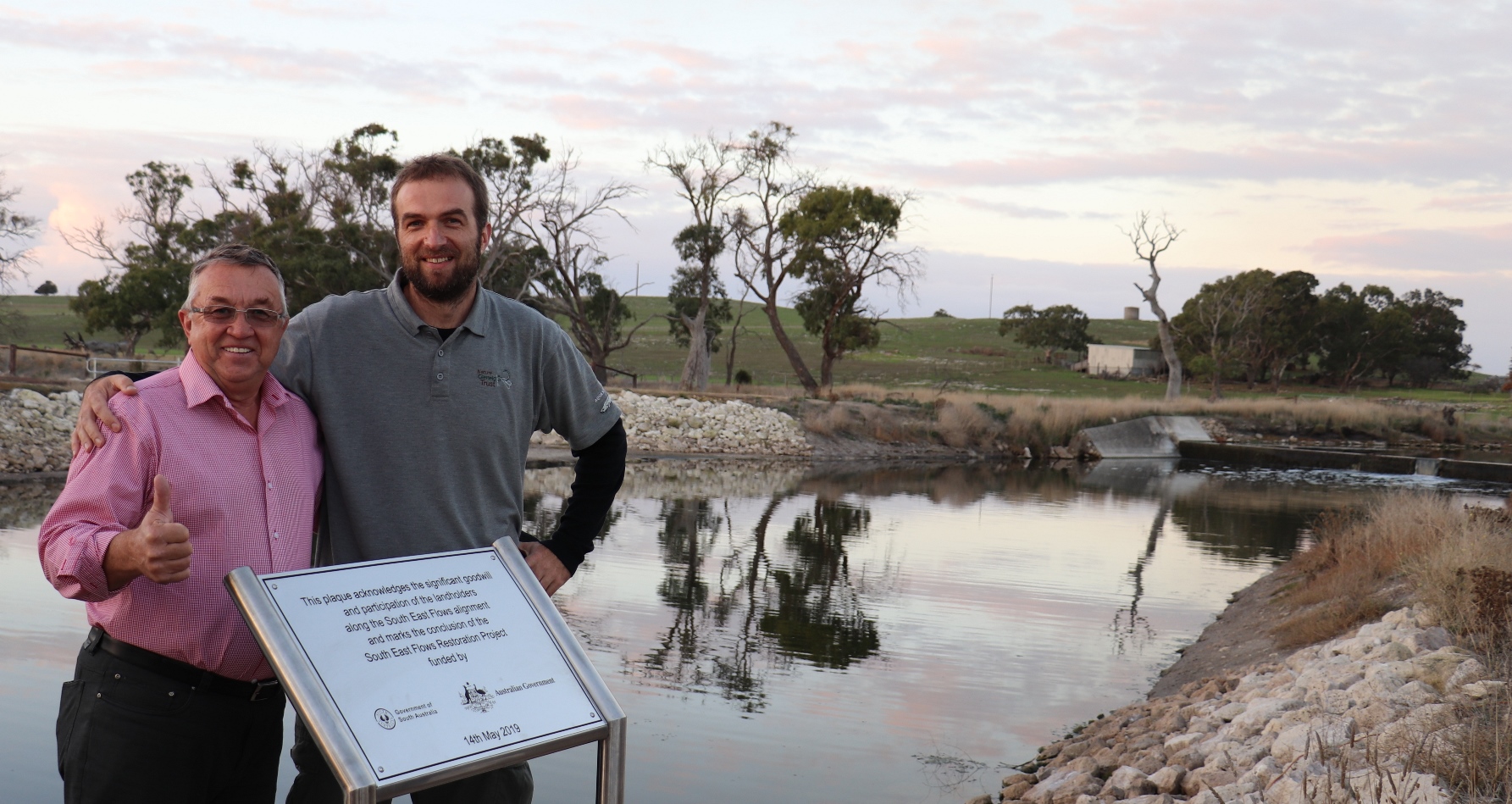Major milestone for wetlands in the Upper South East – Completion of the South East Flows Restoration project
Last week I attended a small gathering near Kingston in the south-east of South Australia, held at the location of the new regulator installed on Blackford Drain. The regulator and off-take channel at the site are key pieces of infrastructure in the South East Flows Restoration Project; redirecting environmental flows to the Coorong and associated wetlands in the Upper South East drainage network.

Landholders, project staff and others, at the new regulator on Blackford Drain. This infrastructure can redirect flows towards the Coorong and a restored Tilley Swamp, via a new channel (behind the photographer). Photo: Mark Bachmann.
Natural Resources South East staff (of the SA Department for Environment and Water (DEW)) organised the event to thank landholders, staff, consultant engineers, contractors and wide range of other people who made the project possible. Mark de Jong (DEW), Frank Brennan (Chair of the South Eastern Water Conservation and Drainage Board (SEWCDB)) and Tim Collins (DEW) spoke on behalf of the project, and described how such an enormous and incredibly complex piece of work, with far-reaching impacts, actually came together. To learn more about the project, please visit the Natural Resources South East website.

Some of the many DEW staff involved in the delivery of the South East Flows Restoration Project : Sarah Hender, Mark de Jong, Bronwyn Leggett, Tim Collins, Bob Furner (now retired), Matthew Honner and Ben Taylor (now Senior Ecologist with NGT since 2017). Photo: Alison Boomsma, Natural Resources South East.
I am also incredibly proud to share with you how last week’s event neatly rounded off a journey that began for Nature Glenelg Trust four and a half years ago (see the initial story from 2014, and this update from mid-2015). It was back then, starting in December 2014, that NGT began actively talking with the community, landholders, project staff and senior representatives of the state and federal government, because the initial plans for the project were for a “drain only” design that unfortunately would have bypassed the expansive (but long dehydrated) wetlands of Tilley Swamp.
As an alternative, we sought to explain how that initial design could be ‘tweaked’ to maximise the potential environmental benefits for wetlands in the Upper South East – especially Tilley Swamp – en route to the Coorong. The main advantage of this alternative design option is that when releases into the Coorong via Salt Creek are not immediately required, Tilley Swamp could be used as a major storage area (instead of Blackford Drain water being lost to the sea at Kingston). Not only would this result in the immediate restoration of more than 4000 hectares of wetlands, but it would also provide future managers with much greater choice and flexibility when deciding the timing, volume and quality of releases (when and if required) into the Coorong.
However, as you might imagine, seeking to influence the fundamental design philosophy of a $60M joint state and federal government project with considerable momentum, at the 11th hour (and with construction deadlines looming), was extremely complex and presented a range of seemingly insurmountable challenges.
With that context in mind, it was truly tremendous to witness the cooperation and genuine goodwill ultimately shown by everyone involved to achieve a better outcome for wetlands in the Upper South East over the subsequent two years. This culminated in a formal commitment by the Hon. Ian Hunter MLC, the then SA Minister for the Environment, to a revised project design incorporating the “watercourse option” in September 2016, largely based on the NGT proposal from 2014 (see this update from 2016).
Fast forward to last week, the 14th of May 2019, and it was amazing to see everything in place on the ground, capping off the final phase of a project that had been under development since 2007. Now we await the winter 2019 rains, which will trigger Blackford Drain flows and enable the first northerly diversions towards Tilley Swamp. When that occurs, instead of running out to sea, vast amounts of additional water will be retained in this part of the South East landscape once again!
Finally, some acknowledgements:
- This project simply would not be happening without the commitment of Tom Brinkworth and family, and Wetlands and Wildlife, who own and manage the majority of land to be re-inundated in Tilley Swamp, as well the other landholders along the 90 km alignment. A heart-felt thank you for making the previously impossible dream of a restored Tilley Swamp a reality!
- Successful delivery of the revised project benefitted from an exceptional level of commitment over several years from DEW and the SEWCDB, especially Regional Director Tim Collins and the project team (see photo above).
- Bob Furner, DEW’s project manager, deserves a special mention. Bob had the incredibly difficult task of preparing his team for planning and potentially implementing the revised design during an extended period of uncertainty – which presented some serious logistical challenges. Despite this, Bob got everything on track and handed the project over in excellent shape (at the time of his retirement) to Mark de Jong to oversee the completion of works. The results of Bob’s hard work, including his unique, thorough (some might say legendary) approach to project management, are now out there on the ground for all to see. Great work Bob, and to everyone else who played their part!
The loss of wetlands in Tilley Swamp began with the first attempts at drainage into Salt Creek in the 1860s and has continued ever since. It is certainly a proud day for the South East when we can say that a stubbornly entrenched, long-term trend of wetland loss in the region, has finally been reversed at such a meaningful scale in 2019.
Our next update will hopefully include vistas of a restored Tilley Swamp, filling with water again … so watch this space!

